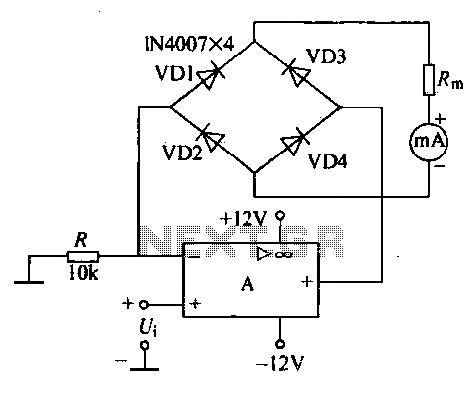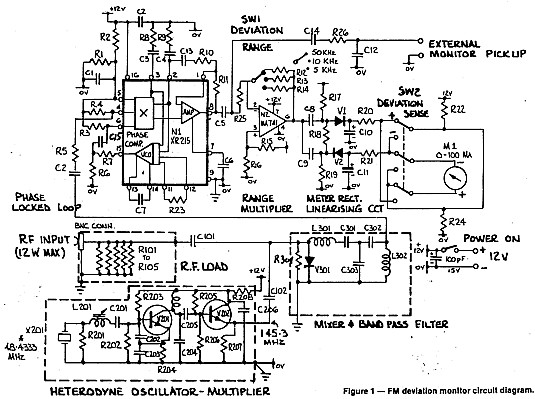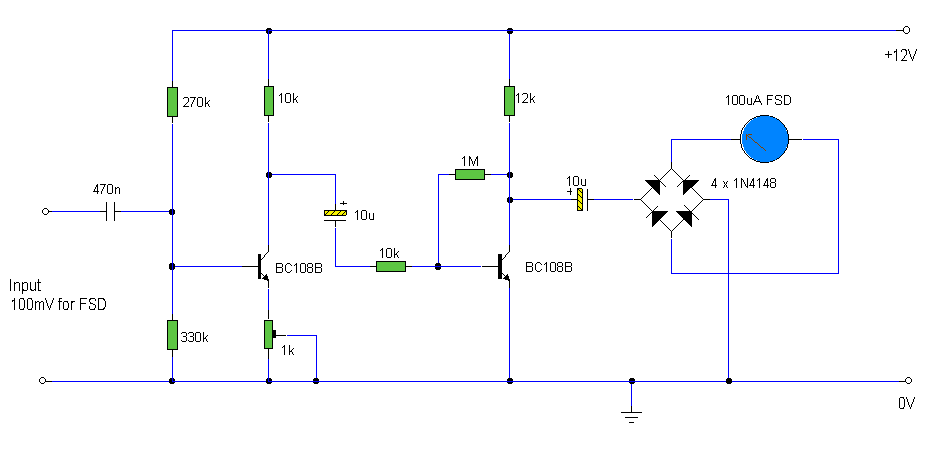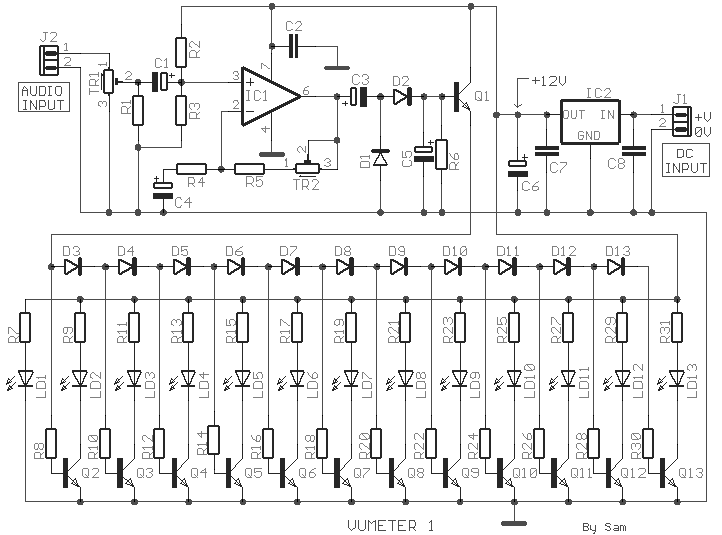
Digital capacitance meter
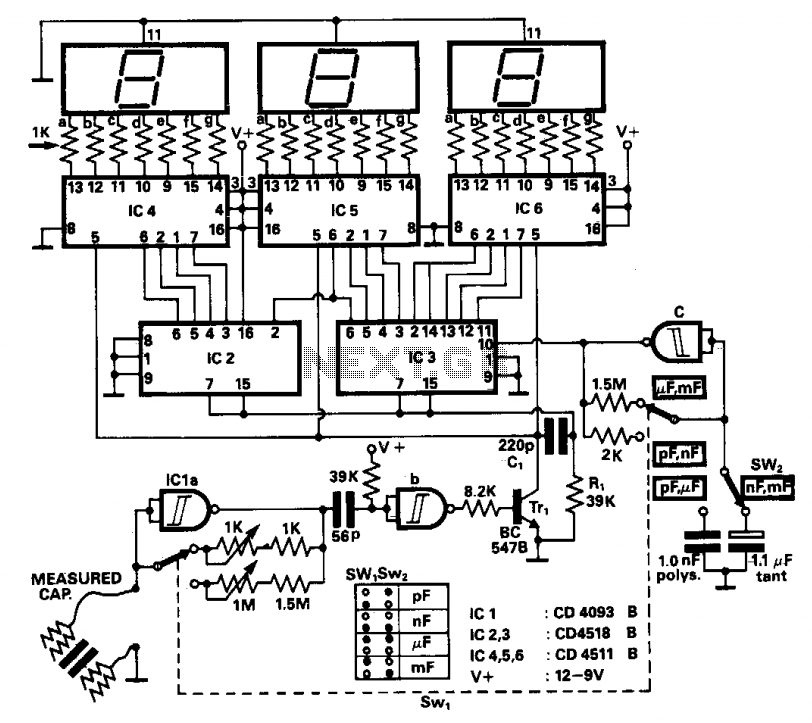
The operation principle involves counting the number of pulses generated by a constant frequency oscillator over a fixed time interval, which is produced by another lower frequency oscillator. This lower frequency oscillator utilizes the capacitor being measured as the timing element. The measurement of capacitance is proportional to the pulse count during the specified time interval. The astable oscillator created by IC1c generates a pulse train of constant frequency. Additionally, gate IC1a also functions as an oscillator, with its oscillation period approximately described by the equation: T = 0.7 RC. The period is linearly dependent on the capacitance C and serves as the time interval for a single measurement. A differentiator network following the oscillator generates negative spikes, which are shaped into narrow pulses by the NAND Schmitt Trigger IC1b. The differentiator, composed of R1 and C1, produces a negative spike that resets the counters. The display indicates the number of high-frequency oscillator pulses that enter the counter during the measurement period.
The described circuit operates as a capacitance measurement system utilizing an astable multivibrator configuration. The primary oscillator, represented by IC1c, is designed to produce a stable pulse train at a constant frequency. The frequency of this oscillator is critical as it serves as the reference for counting pulses. The lower frequency oscillator, represented by gate IC1a, is dependent on the variable capacitance C, which is the capacitor being measured. The relationship between the capacitance and the time period T of the oscillator is linear, allowing for accurate measurements of capacitance based on the timing characteristics.
The differentiator network, comprising resistor R1 and capacitor C1, plays a vital role in shaping the output signal from the oscillator. It generates a sharp negative spike in response to the leading edge of the pulse train. This negative spike is crucial as it triggers the NAND Schmitt Trigger (IC1b), which further conditions the signal into narrow pulses suitable for counting. The reset function of the counters ensures that each measurement cycle starts afresh, allowing for accurate counting of the pulses generated by the high-frequency oscillator.
The counting mechanism captures the number of pulses occurring within the time interval defined by the lower frequency oscillator. The display unit provides a visual representation of the counted pulses, which correlates directly to the capacitance value of the capacitor under test. This method of capacitance measurement is efficient and provides a digital output that is easy to read and interpret, making it suitable for various applications in electronic testing and measurement.The principle of operation is counting the pulse number derived from a constant frequency oscillator during a fixed time interval produced by another lower frequency oscillator. This oscillator uses the capacitor being measured as the timing. The capacitance measurement is proportional during pulse counting during a fixed time interval. The astable oscillator formed by IClc produces a pulse train of constant frequency. Gate ICla also forms an oscillator whose oscillation period is given approximately by the equation: T = 0.7 RC.
Period ? is linearly dependent on the capacitance C. This period is used.as the time interval for one measurement. The differentiator network following the oscillator creates the negative spikes shaped in narrow pulses by IClb NAND Schmitt Trigger. The differentiator formed by Rl and CI produces a negative spike which resets the counters. The display shows the number of high frequency oscillator pulses entering the counter during the measurement period.
🔗 External reference
The described circuit operates as a capacitance measurement system utilizing an astable multivibrator configuration. The primary oscillator, represented by IC1c, is designed to produce a stable pulse train at a constant frequency. The frequency of this oscillator is critical as it serves as the reference for counting pulses. The lower frequency oscillator, represented by gate IC1a, is dependent on the variable capacitance C, which is the capacitor being measured. The relationship between the capacitance and the time period T of the oscillator is linear, allowing for accurate measurements of capacitance based on the timing characteristics.
The differentiator network, comprising resistor R1 and capacitor C1, plays a vital role in shaping the output signal from the oscillator. It generates a sharp negative spike in response to the leading edge of the pulse train. This negative spike is crucial as it triggers the NAND Schmitt Trigger (IC1b), which further conditions the signal into narrow pulses suitable for counting. The reset function of the counters ensures that each measurement cycle starts afresh, allowing for accurate counting of the pulses generated by the high-frequency oscillator.
The counting mechanism captures the number of pulses occurring within the time interval defined by the lower frequency oscillator. The display unit provides a visual representation of the counted pulses, which correlates directly to the capacitance value of the capacitor under test. This method of capacitance measurement is efficient and provides a digital output that is easy to read and interpret, making it suitable for various applications in electronic testing and measurement.The principle of operation is counting the pulse number derived from a constant frequency oscillator during a fixed time interval produced by another lower frequency oscillator. This oscillator uses the capacitor being measured as the timing. The capacitance measurement is proportional during pulse counting during a fixed time interval. The astable oscillator formed by IClc produces a pulse train of constant frequency. Gate ICla also forms an oscillator whose oscillation period is given approximately by the equation: T = 0.7 RC.
Period ? is linearly dependent on the capacitance C. This period is used.as the time interval for one measurement. The differentiator network following the oscillator creates the negative spikes shaped in narrow pulses by IClb NAND Schmitt Trigger. The differentiator formed by Rl and CI produces a negative spike which resets the counters. The display shows the number of high frequency oscillator pulses entering the counter during the measurement period.
🔗 External reference
Warning: include(partials/cookie-banner.php): Failed to open stream: Permission denied in /var/www/html/nextgr/view-circuit.php on line 713
Warning: include(): Failed opening 'partials/cookie-banner.php' for inclusion (include_path='.:/usr/share/php') in /var/www/html/nextgr/view-circuit.php on line 713
